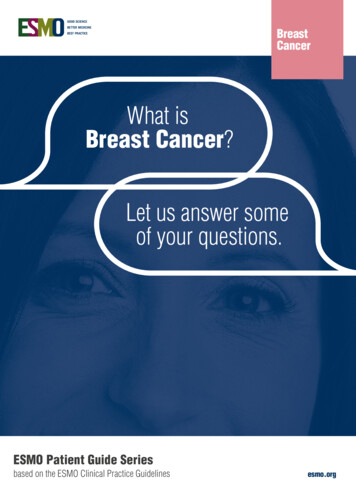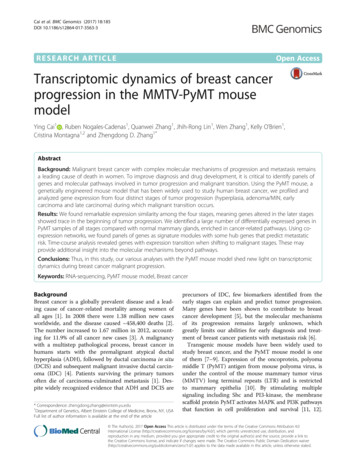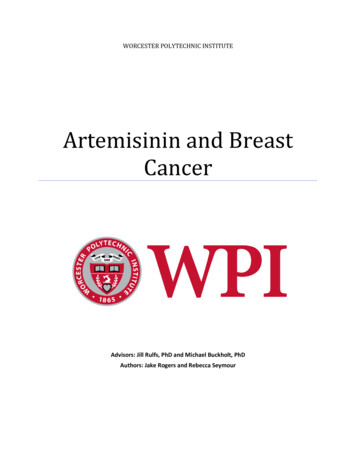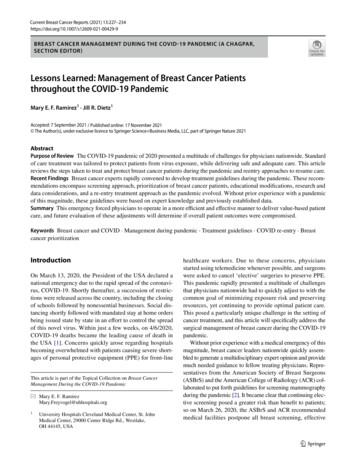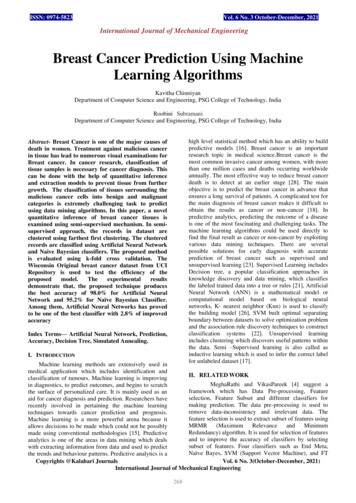
Transcription
ISSN: 0974-5823Vol. 6 No. 3 October-December, 2021International Journal of Mechanical EngineeringBreast Cancer Prediction Using MachineLearning AlgorithmsKavitha ChinniyanDepartment of Computer Science and Engineering, PSG College of Technology, IndiaRoobini SubramaniDepartment of Computer Science and Engineering, PSG College of Technology, Indiahigh level statistical method which has an ability to buildpredictive models [16]. Breast cancer is an importantresearch topic in medical science.Breast cancer is themost common invasive cancer among women, with morethan one million cases and deaths occurring worldwideannually. The most effective way to reduce breast cancerdeath is to detect at an earlier stage [28]. The mainobjective is to predict the breast cancer in advance thatensures a long survival of patients. A complicated test forthe main diagnosis of breast cancer makes it difficult toobtain the results as cancer or non-cancer [18]. Inpredictive analytics, predicting the outcome of a diseaseis one of the most fascinating and challenging tasks. Themachine learning algorithms could be used directly tofind the final result as cancer or non-cancer by exploitingvarious data mining techniques. There are severalpossible solutions for early diagnosis with accurateprediction of breast cancer such as supervised andunsupervised learning [23]. Supervised Learning includesDecision tree, a popular classification approaches inknowledge discovery and data mining, which classifiesthe labeled trained data into a tree or rules [21], ArtificialNeural Network (ANN) is a mathematical model orcomputational model based on biological neuralnetworks, K- nearest neighbor (Knn) is used to classifythe building model [26], SVM built optimal separatingboundary between datasets to solve optimization problemand the association rule discovery techniques to constructclassification systems [22]. Unsupervised learningincludes clustering which discovers useful patterns withinthe data. Semi –Supervised learning is also called asinductive learning which is used to infer the correct labelfor unlabeled dataset [17].Abstract- Breast Cancer is one of the major causes ofdeath in women. Treatment against malicious cancerin tissue has lead to numerous visual examinations forBreast cancer. In cancer research, classification oftissue samples is necessary for cancer diagnosis. Thiscan be done with the help of quantitative inferenceand extraction models to prevent tissue from furthergrowth. The classification of tissues surrounding themalicious cancer cells into benign and malignantcategories is extremely challenging task to predictusing data mining algorithms. In this paper, a novelquantitative inference of breast cancer tissues isexamined using semi-supervised mechanism. In semisupervised approach, the records in dataset areclustered using farthest first clustering. The clusteredrecords are classified using Artificial Neural Networkand Naive Bayesian classifiers. The proposed methodis evaluated using k-fold cross validation. TheWisconsin Original breast cancer dataset from UCIRepository is used to test the efficiency of theproposedmodel.Theexperimentalresultsdemonstrate that, the proposed technique producesthe best accuracy of 98.0% for Artificial NeuralNetwork and 95.2% for Naïve Bayesian Classifier.Among them, Artificial Neural Networks has provedto be one of the best classifier with 2.8% of improvedaccuracyIndex Terms— Artificial Neural Network, Prediction,Accuracy, Decision Tree, Simulated Annealing.I. INTRODUCTIONMachine learning methods are extensively used inmedical application which includes identification andII. RELATED WORKclassification of tumours. Machine learning is improvingMeghaRathi and VikasPareek [4] suggest ain diagnostics, to predict outcomes, and begins to scratchframework which has Data Pre-processing, Featurethe surface of personalized care. It is mainly used as anselection, Feature Subset and different classifiers foraid for cancer diagnosis and prediction. Researchers havemaking prediction. The data pre-processing is used torecently involved in pertaining the machine learningremove data-inconsistency and irrelevant data. Thetechniques towards cancer prediction and prognosis.feature selection is used to extract subset of features usingMachine learning is a more powerful arena because itMRMR(MaximumRelevanceandMinimumallows decisions to be made which could not be ffeaturesmade using conventional methodologies [15]. Predictiveand to improve the accuracy of classifiers by selectinganalytics is one of the areas in data mining which dealssubset of features. Four classifiers such as End Meta,with extracting information from data and used to predictNaïve Bayes, SVM (Support Vector Machine), and FTthe trends and behaviour patterns. Predictive analytics is aCopyrights @Kalahari JournalsVol. 6 No. 3(October-December, 2021)International Journal of Mechanical Engineering268
Breast Cancer Prediction Using Machine Learning Algorithms(Function Tree) is used. After extracting the relevantfeatures from the data set, classifier is applied to checkthe performance in terms of accuracy. The classifiers aretrained using training set, and then classificationalgorithm is applied one by one and SVM with MRMRproduces better results. The disadvantage is selectedfeatures are correlated strongly and it is mutually faraway from each other due to which it has high correlationand redundant features.Hamid Mohamadi, JafarHabibi, MohammadSanieeAbadehand HamidSaadi [7] proposes a simulatedannealing based Fuzzy Classification System (SAFCS).SAFCS generates a fuzzy if-then rules and temperatureinitialization. The procedure is repeated k times. Thentemperature is decremented using cooling parameter anditerates until the stopping criterion is reached. SAFCS iscompared with C4.5 which is based on entropy criteriaand pruning techniques, inorder to discard the parts of atree. These classification methods are applied to differentdatasets, among them SAFCS achieves better results interms of accuracy for both training set and testing set. Thedisadvantage of SAFCS is difficult to fix the coolingparameter and time consuming.Animesh Hazra, Subrata Kumar Mandal, Amit Gupta[8] the main objective is to find the smallest subset offeatures that can ensure a best accurate classification ofbreast cancer. It compares three classifiers Naïve bayes,SVM and ensemble classifier. After pre-processing, thecomparison is carried out in three ways such as Featureselection using Pearson correlation coefficient, Pearsoncorrelation with binning and principal componentanalysis. The Pearson correlation is used to reveal abouthow much the class attributes and attributes of data setare related based on which the features are ranked. Insecond methodology after data cleaning and Pearsoncorrelation coefficient, discretization of binning techniquewas applied. In the next method, feature extraction wasperformed with principal component analysis (PCA) afterpre-processing. Then classification technique wasapplied, among all classifiers naïve bayes provides betteraccuracy percentage and time complexity. Thedisadvantage is execution time for prediction model andPCA maps the data into lower dimensional space due towhich performance of classifier is degraded.redirecting URL between pages as edges and links arerepresented as 1/0. The clusters are formed in which URLacts as objects for cluster and a threshold criterion is setfor clusters [5]. The website structure depends on thethreshold criterion of the clustering. It is difficult toassign the threshold criterion is the disadvantage.SunitaSoni, O.P.Vyas [12] discusses aboutassociation rule mining, associative classifiers andadvanced classifier rule mining. Classification usingassociation rule mining is a predictive analytics techniquewhich discovers a subset of rules to predict an accurateclassifier called Classifier Association Rule (CAR). Theadvanced CAR provides better accuracy which dependson set of rules before applying classifiers. The associativeclassifiers using Fuzzy association rule, deals with sharpboundary problems. The fuzzy and weighted associativeclassifier provides a greater accuracy when compared toother associative classifiers. The disadvantage isdifficulty in handling temporal data which is beingdynamic. The rules predicted are not static and it hasadditionally related attributes.Ibrahim M. El-Hasnony, Hazem M. El-Bakry,Ahmed A. Saleh [13] discusses a hybrid methodology ofK-means, Feature reduction with feature selection (FRFS)and discrenibility K-nearest neighbor (D-Knn) classifier.The hybrid feature selection and data reduction method isused for combining the rough set features and calculatingthe attribute dependencies. The classifier makes decisionsat each point and classifies the data by contrasting test setis called Instance based learning (IBL). Knn assumes thatclass label for each record is same for nearest neighborwhich is simple that helps to enhance its predictiveaccuracy. The disadvantage is to determine value ofparameter computation cost is quite high.III. METHODOLOGIESThe following are the research methods employed in thispaper.A. Data collection and Pre- ProcessingThe dataset is collected from UCI Machine learningdata repository of Wisconsin (Original) Breast cancerdataset (WBC). WBC has 699 instances, 2 class labels (2for Benign/4 for Malignant) and 11 attributes. Theattributes are integer valued. The WBC dataset isprovided in Table I.Mohamed Junaid.K.A, [10] discusses about twolayer neural network back propagation algorithm. Duringlearning phase, the network learns by adjusting theweights and takes longer learning time. As a result,TABLE I. DATASET DESCRIPTIONparallelization techniques are used to speed up thecomputation process and outperforms in terms ofS.NOATTRIBUTEDOMAINaccuracy. As a result of two layer neural networks,1.Sample Code NumberId numberparallelization techniques are used to speed up the2.Clump Thickness1-10computation process and outperforms in terms of3.UniformityofCellSize1-10accuracy. The disadvantage of this approach is too many4.UniformityofCellShape1-10hidden neurons and difficult to train the network.Deepshree A.Vadeyar,Yogish H.K [11] focuses on5.Marginal Adhesion1-10farthest first clustering for reorganization of website6.Single Epithelial Call 1-10structure to improve user navigation. The websites areSizeconsidered as a graph, each node as a web page,Copyrights @Kalahari JournalsVol. 6 No. 3(October-December, 2021)International Journal of Mechanical Engineering269
Kavitha Chinniyan, Roobini Subramani7.8.9.10.11.Bare NucleiBland ChromatinNormal NucleoliMitosesClassfinal temperature and temperature decrement. The finalcluster structure depends on how the cooling is performed[9]. The ideal cooling rate is difficult to compute. Thetemperature decrement is given by,1-101-101-101-102-benign,4-malignantf(t) t α(1)The dataset contains missing values ‘?’ is preprocessed by single imputation method, i.e., the meanvalue of a variable. The advantage is sample meanremains unchanged [25].Where,t time in minutes, which lies between [1, ]B. Fuzzy C-Means ClusteringThe clustering has been classified as soft clustering andhard Clustering. In hard clustering, the data point belongsto exactly one cluster. In Soft Clustering, the data pointcan belong to more than one cluster [14]. The Fuzzy CMeans Clustering (FCM) algorithm is an unsupervisedand soft clustering algorithm, which introduces thefuzziness for an object. The main limitations are sensitiveto noises, minimizes an objective function and difficult toselect appropriate parameters. The algorithm is providedin Table II.In algorithm, whereK Number of IterationsVj jth cluster centerm Fuzziness Index [1, ]C Number of Cluster Centerµij membership of ith data to jth cluster centerdij Eucledian distance between ith data and jthclustercenterxi Original data pointn Number of Data PointsD. Decision Tree [C4.5]Decision Tree is a supervised algorithm which can beused for classification problems. C4.5 is also a type ofdecision tree which is improved from ID3 algorithm bydealing with both continuous and discrete attributes,missing values and pruning trees [2].C4.5 builds decisiontrees from a set of training data by calculating theinformation gain for each attribute. The complexity of adecision tree is, the tree becomes unstable even whenthere is a small change in entropy value [21]. It will resultin a generation of different tree. The sub trees replicatedseveral times.α Cooling rate which lies between 0.5 - 0.99Entropy( S ) p p log 2 p n p n n n log 2 p n p n (2)The attribute with highest information gain is taken asa root for decision tree [27]. In the equation 2, wherep Number of positive classesn Number of negative classes.The algorithm steps are provided in Table III.TABLE II.FUZZY C-MEANS CLUSTERINGALGORITHMTABLE III. DECISION TREE [C4.5] ALGORITHMAlgorithm: Fuzzy C-means Clustering AlgorithmInput : Pre-processed datasetOutput : Clustered cancer dataset1. Randomly ‘C’ Cluster centres are selected.2. Calculate fuzzy membership matrix.C. Simulated AnnealingSimulated Annealing is an iterative method which ismainly used as an optimization search paradigm to escapefrom local minima and to achieve global optima. Thisoptimization can be done by accepting moves whichdegrades the probability on a parameter calledtemperature. The temperature is gradually decreased byusing cooling schedule [1]. The algorithm behavior endswhen the temperature reaches to zero. The parameterrequired for simulated annealing are starting temperature,c ij 1 / (dij / dik ) (2 / m 1)k 13.Compute Fuzzy centers ‘Vj’ usingnni 1i 1Vj ( (( ij) m) xi ) / (( ij) m), j 1,2.c4.Repeat 2 & 3 until minimum J value isachievedncJ (u, v) (( ij) m))( xi vj 2)i 1 j 1Copyrights @Kalahari JournalsVol. 6 No. 3(October-December, 2021)International Journal of Mechanical Engineering270
Breast Cancer Prediction Using Machine Learning Algorithmsnumber of variables (features/predictors) for training themodel. Naive Bayesian classifier is based on Bayes’theorem and the theorem of total probability. TheAdvantages of Naïve Bayesian Model are: It is a simple classifier because it has anunderlying probabilistic model. Requires only small amount of data to train themodel. If the independence assumption holds well, NBClassifier performs well and provides betterresults.Algorithm: Decision Tree (C4.5)Input : Training dataset (D)Output : Decision Tree (T)Tree{}if D is “pure” OR other stopping criteria met thenterminateend iffor all attribute a D doCompute information gain to split on ‘a’end forabest Best attribute according to gain calculatedTree Create a decision node that tests abest in the rootDv Induced sub – datasets from D based on abestfor all DvdoTreev C4.5(Dv)Attach Treev to the corresponding branch of treeend forreturn TreeThe probability with vector x x1. xn belongs tohypothesis h is,P(Y X 1,. Xn) P( X 1,. Xn Y ) / P( X 1, X 2. Xn)(3)Where, X Number of predictors.Y Class of probability.E. Farthest First Clustering algorithmFarthest First clustering is a type of Hard Clusteringalgorithm in which one data point can belong to only onecluster [20]. It is similar to K-Means clustering algorithmit chooses centroids and assigns objects in cluster withmax distance. Farthest first clustering solves k-centerproblem and it is very efficient for large set of data. Infarthest first algorithm, the mean for calculating centroidis not required which takes centroid arbitrary and distanceof one centroid from other is maximum [24]. Aftercalculating centroid, the points with minimum distanceare assigned to clusters. The algorithm is provided inTable IV.TABLE V. BACK PROPAGATION ALGORITHMG. Artificial Neural NetworkThe artificial neural network (ANN) was implementedusing back propagation architecture. Each of the layershas certain elements called as neurons, which has inputlayer, hidden layer and output layer. The input layer isselected based on the features and output layer has twoneurons either as benign or malignant [15]. The transferfunction is computed as a weighted sum of input signals.The learning capability of an artificial neuron is achievedby adjusting the weights of neurons. Initially, the processis carried out as forward pass, then back propagation isapplied to achieve target node. Back Propagation learnsby iteratively processing a set of clustered samples. Foreach sample, weights are modified to minimize the errorbetween network’s classification and actual classificationProcess [29]. The algorithm of ANN is provided in TableV. The advantages of ANN are [30]: ANN is used to solve complex problems. Less effort is required to train the networkmodel. Implicitly detects Complex non – linearrelationshipbetweendependantandindependent variables. Ability to detect all possible interactionsbetween predictor (attributes) variables.TABLE IV. FARTHEST FIRST CLUSTERINGALGORITHMAlgorithm: Farthest First ClusteringInput : Pre-processed datasetOutput : Clustered cancer datasetSteps :1. Pick any data point and label it as point 12. For i 2,3, ,n3. Find the unlabelled point furthest from{1,2, ,i-1} andlabel it as i.//Use d(x,S) minyєS d(x,y) to identify the distance ofapoint from a set4. π(i) argmin j i, d(i,j)5. Ri d(i,π(i))F. Naïve BayesianIn machine learning, naïve bayes algorithm is a simpleprobabilistic classifiers based on Bayes theorem withstrong independence assumptions between the features[6]. Naive Bayes classifiers are highly scalable whichrequires a number of parameters to be linear and theCopyrights @Kalahari JournalsVol. 6 No. 3(October-December, 2021)International Journal of Mechanical Engineering271
Kavitha Chinniyan, Roobini Subramani i Number of Iterations.FCM provides K-center problem ie. Distancesbetween cluster centers should satisfy thetheory, triangle of inequality.Computationally expensive, difficult to fixthresholds and cooling rate.In decision tree, normally over fitting occurs,then pruning is required due to which accuracygets decreased.C. Proposed SystemIn proposed model, farthest first clustering and NaïveBayesian model is used for diagnosis of breast cancer.Farthest first clustering is used to cluster the preprocessed dataset as given in table 3. In existing work,simulated annealing was used to optimize the clusters.The farthest first clustering does not provide localoptimum even in worst case so it does not requireoptimization. Farthest first clustering always providesglobal optimum so, it guarantees to provide optimalsolution. In our proposed model, two clusters areconsidered because it has only two labels such as benignand malignant. After clustering, Naïve Bayesian modeland Artificial Neural Network is used to classify theclustered data and labels are predicted either as Benign orMalignant. Then, it is cross validated using K-fold crossvalidation. In this k 10, the dataset is divided into 10equal subsets. Each subset acts as testing set, whereas therest of the partition acts as training set. This procedure isrepeated ten times so that each partition is used to testonly once. The proposed system flows as it is beingprovided in figure 2.Figure. 1. Existing System Flow ChartIV. SYSTEM DESIGNIn existing method, the combined approach such as FuzzyC-means clustering with Simulated annealing andDecision tree (C4.5) classifier is used for diagnosis ofbreast cancer. The detailed working of the existingmodule is described as follows :A. Existing SystemThe dataset from UCI repository is used for prediction,in which single imputation pre-processing technique wasused. Then inorder to predict labels, FCM clustering isprocessed [1] on dataset which is then optimized usingSimulated Annealing. In FCM, ‘m’ is a fuzziness indexwhich measures the tolerance for clustering and its valuelies between [1, ]. If the value of ‘m’ is larger, it haslarger overlapping between clusters. m 1 for crisp and 2for fuzzy clustering. In this research [19], m 1.4 ischosen as fuzzy index. Then, the clustered data isannealed for which the cooling schedule is chosen asf(t) 4. The starting and final temperature is chosen asminimum and maximum of a feature in a random manner.After clustering with annealing, C4.5 classifiers are usedto classify the clustered dataset and labels are predictedeither as Benign or Malignant. The model is then crossvalidated using K-fold cross validation, here K 10. Theexisting system flows as it is being provided in figure 1.D. Advantages of Proposed modelThe advantages of proposed model are: FFC Clustering computation time is O(nk)Where, n Number of data points.k numberof clusters. FFC achieves global optimum because it doesnot require iteration cluster formation takesplace in a single pass. Farthest first solves K-center problem ie.,itachieves triangle of inequality property. Artificial Neural Network (ANN) and NaiveBayesian provide optimal solution because itperforms well does not over fit. It is a simple classifier with high accuracy.B. Disadvantages of existing modelThe drawbacks of existing model are: FCM clustering takes O (ndc2i) as acomputation time to cluster the dataset andoptimized by simulated annealingwhere,n Number of Data Points.d Number of dimensions.c Number of Clusters.Copyrights @Kalahari JournalsVol. 6 No. 3(October-December, 2021)International Journal of Mechanical Engineering272
Breast Cancer Prediction Using Machine Learning AlgorithmsE. AccuracyThe classifiers accuracy is an important metric forevaluation. It is a ratio of positive tuples and negativetuples against all the tuple. It is given by,Accuracy TP TN / TP TN FP FN(7)F. Error RateThe error rate is an essential measure for evaluation.Lower error rate is said to be a better classifier. Error ratedetermines the error between the prediction and actual. Itis given by,Error rate FP FN / TP TN FP FN(8)TABLE VI: CONFUSION MATRIX FOR DECISIONTREE [C4.5]Testing ositive(FP)FalseNegative(FN)50 -50 %2190130060 – 40 %17201080V. EXPERIMENTS AND RESULTS75 - 25 %1100650A. Performance MetricsIn this experiment, the medical data related to breastcancer classification is initiated with the preprocessingusing mean imputation which is followed by the farthestfast clustering. The clustered data is classified usingartificial neural network and naive Bayes, to predict thetumors. The performance of classifier is validated basedon error rate and mean accuracy. The performancemetrics are precision, recall, F-Measure, error rate andaccuracy [20].80 – 20%118022090 – 10 %430270Figure 2. Proposed System Flow ChartTABLE VII: CONFUSION MATRIX FOR NAÏVEBAYES MODELB. PrecisionPrecision is a ratio of true positive tuple and allpositive tuple in a dataset. It is used to measure theexactness or quality. Precision is given by,Precision TP / TP FP(4)C. RecallRecall is a ratio of true positive tuple against positiveand negative tuple. Recall is the measure of completenessor quality. It is also called as sensitivity. Recall is givenby,Recall TP / TP FN(5)D. F-MeasureF – Measure is also called as F – Score. F –Measure isa mean of precision and recall. F- Measure value variesfrom 0 to 1. If the value of F-Measure is higher, then it issaid to be a better classifier. It is given by,F – Measure 2 * ((precision * Recall) /(Precision Recall))(6)Testing ositive(FP)FalseNegative(FN)50 -50 %2825001760 – 40 %2125611175 - 25 %143240880 – 20%110220890 – 10 %571003G. Confusion MatrixThe confusion matrix is used to describe the performanceof a classifier. True positive (TP) refers to positive tupleand True Negative (TN) refers to negative tuple classifiedby the basic classifiers.False Positive (FP) refers topositive tuple but predicted as negative and FalseNegative (FN) refers to negative tuple but predicted aspositive which is incorrectly classified by the classifiers.The training dataset is used to train the classifiers. Thecorrectly classified instances and incorrectly classifiedinstances for existing model ie., Decision Tree [C4.5] isprovided in the table VI. The Proposed model ie., NaïveBayes model in table VII and Artificial Neural Network isprovided in table VIII.Copyrights @Kalahari JournalsVol. 6 No. 3(October-December, 2021)International Journal of Mechanical Engineering273
Kavitha Chinniyan, Roobini SubramaniTABLE VIII: CONFUSION MATRIX FORARTIFICIAL NEURAL NETWORK [ANN]Testing ositive(FP)FalseNegative(FN)50 -50 %291491860 – 40 %218561575 - 25 %145240680 – 20%11422090 – 10 %58100TABLE XI. EVALUATION METRICS OBTAINEDFOR FARTHEST FIRST CLUSTERING ANDARTIFICIAL NEURAL NETWORK uracy(%)Errorrate450 -50 029Balancedaverage0.99830.96340.980398.0%0.02TABLE IX. PERFORMANCE METRICS EVALUATEDFOR FUZZY C-MEANS CLUSTERING (FCM) racy(%)Errorrate50 -50 alancedAverage0.66481.0000.794466.4%0.3352H. ResultsThe experiments have been done on R-studio ofversion 3.0.3.The results for existing and proposed modelare shown in Table IX, X and X1. The table describes theperformance of the model in terms of accuracy, precision,recall, f-measure and error rate. The result shows that theclassifier with Farthest First Clustering (FFC) providesbetter accuracy with lower error rate. The Farthest FirstClustering clusters the data with maximum distance. Thequality of clusters depends on distance between thecluster centers should be farther and the cluster is said tobe well formed. Farthest first clustering satisfies thecriteria when compared to Fuzzy C-Means Clustering.The Farthest First Clustering with Artificial NeuralNetwork provides a better balanced accuracy of 98.0%,lower error rate of 2% with all testing and training phasesbecause ANN has a capability to solve a complex andmimic problem. Due to that, ANN can be used for manyreal world applications which give better results.SIMULATED ANNEALING (SA) AND DECISIONTREE C4.5TABLE X. EVALUATION METRICS Accuracy(%)Errorrate50 -50 NCLUSIONIn this paper, the prediction model for breastcancer is constructed by using classifiers with clustering.The performance of a model is analyzed by comparingthe different classifiers with clustering. The Farthest FirstClustering provides a better prediction compared to fuzzyclusters. The farthest first clustering with Naïve Bayesand Artificial Neural Network classifier providesbalanced accuracy of 95.2% and 98.0%. Therefore,Farthest First Clustering [FFC] with Artificial NeuralNetwork achieves an improved accuracy of 2.8% becauseANN is a powerful machine learning algorithm. ANN issuggested as a better prediction model for diagnosis ofbreast cancer to ensure the long survival of patients. Infuture, ANN with genetic algorithm can be made as ahybrid model to predict the disease which evolves a hugeremark in medical science [31].FOR FARTHEST FIRST CLUSTERING AND NAÏVEBAYESIAN MODELCopyrights @Kalahari JournalsVol. 6 No. 3(October-December, 2021)International Journal of Mechanical Engineering274
Breast Cancer Prediction Using Machine Learning nealing-Based Clustering of Tissue Samples forCancer Diagnosis”, IEEE Journal of Biomedical andHealth Informatics, vol 20, no.2, March 2016.[2]Sonia Singh and Priyanka Gupta, “ComparativeStudy Id3, Cart and C4.5 Decision Tree Algorithm: ASurvey”, International Journal of Advanced InformationScience and Technology (IJAIST), vol.27, no.27, utlier detection in diabetics Classification UsingDatamining techniques” , International Journal of AppliedEngineering Research, ISSN 0973 – 4562, Vol 11, 2016.[4]MeghaRathi, VikasPareek, “Hybrid Approach topredict Breast Cancer using Machine LearningTechniques”, International Journal of Computer Scienceand engineering, May 2016.[5]Digambar A Kulkarni, Vijaylaxmi K Kochari,"Detection of Breast Cancer Using K Means Algorithm"in International Journal of Emerging Technology andAdvanced Engineering Volume 6, Issue 4, April 2016.[6]Murat Karabatak , "A new classifier for breastcancer detection based on Naïve Bayesian inMeasurement”, Elsevier Science Direct , 2015.[7]Hamid Mohamadi, JafarHabibi, MohammadSanieeAbadehand HamidSaadi,” Datamining with asimulated annealing based fuzzy classification system”,Elsevier Science Direct, pp.1824 – 1833, Nov 2013.[8] AnimeshHazra, Subrata Kumar Mandal, Amit Gupta,“Study and Analysis of Breast Cancer Cell Detectionusing Naïve Bayes, SVM and Ensemble Algorithms”,International Journal of Computer Applications(0975 – 8887) Volume 145 – No.2, July 2016.[9] Wei Yang, Luis Rueda, AliouneNgom, “A SimulatedAnnealingApproach to Find the Optimal Parameters for FuzzyClustering Microarray Data”, Elsevier Science Direct,December 2014.[10] Mohamed Junaid.K.A, “Classification Using TwoLayer NeuralNetwork Back Propagation Algorithm”, Scientificresearchpublishing, June 2016.[11] Deepshree A.Vadeyar,Yogish H.K, “Farthest FirstClustering in LinksReorganization”, International Journal of Web &SemanticTechnology (IJ
classification of tumours. Machine learning is improving in diagnostics, to predict outcomes, and begins to scratch the surface of personalized care. It is mainly used as an aid for cancer diagnosis and prediction. Researchers have recently involved in pertaining the machine learning techniques towards cancer prediction and prognosis.
